Rooms, Cubicles, Wards, and Flops
Price normally separated lodging house amenities into three very distinct levels: (1) full private rooms for 25 to 40 cents a night; (2) semiprivate cubicles or open wards for 15 to 25 cents a night; and finally, (3) flophouses that charged from 5 to 10 cents a night for a dry space on an open floor (fig. 5.7).[25] All these prices are for the 1920s.
For 40 cents, the tired laborer in a private-room lodging house had a room, 10 feet by 10 feet or smaller in dimension. In 1913, a San Francisco health inspector gave this telegraphic description of a small 40-cents-a-night lodging house used by both men and women:
Folsom Street rooming house. Three-story frame. Saloon on first floor. Thirty-nine rooms [upstairs]. Skylight in hall does not ventilate. Five inside rooms on
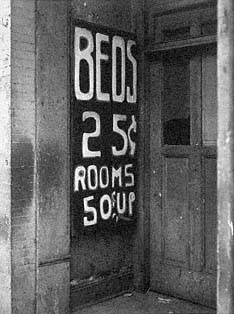
Figure 5.7
Cheap lodging house rates.
The entrance to a skid row hotel on West
Main Street in Norfolk, Virginia, in 1941.
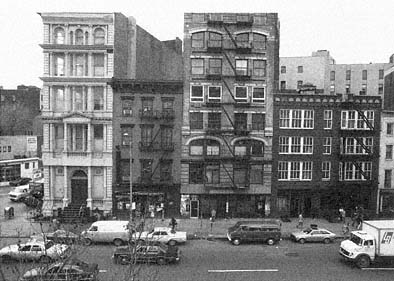
Figure 5.8
Hotels on the Bowery in New York City, photographed in 1986.
These tall lodging houses and other structures remain
from the years before World War I.
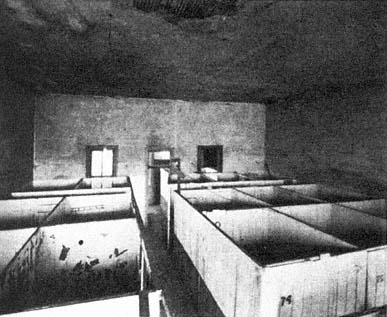
Figure 5.9
Cubicles in a high-ceilinged loft space, photographed before 1923.
The partitions are about 7 feet tall.
each floor have window in unventilated hall. One fire escape; one stairway; large hall; four toilets; four baths; twelve stationary basins. Hot water in bath rooms. . . . Many rooms have double beds.[26]
As the inspector's figures show, each floor had a men's and women's bathroom, for a ratio of one bath to every ten rooms. In most cheap lodging houses, the one to five rooming house ratio fell to one to ten or one to twenty—a ratio hovering at or below the legal minimums.[27] For the entire building, in Chicago or New York, five or more stories were common (fig. 5.8). In smaller cities, three or four stories were the rule.
Inside the 40-cent lodging house, the minimum list of room furnishings might be only a dilapidated bed (sometimes with a straw mattress), one rickety chair, and a hook for clothes. At the very best, conditions might match those of the largest cheap lodging house in San Francisco, the Central Hotel, where the 440 rooms were tiny, but most had a small dresser and a basin with hot and cold running water.[28]
For only 25 cents (again, in 1920s prices), the tired and nearly broke renter could stay in either a cubicle- or a ward-style lodging house. The patrons called the cubicles "cages" or "cribs": they were stalls made of wood or corrugated iron partitions about seven feet high. These partial walls offered visual privacy inside large loft spaces whose ceilings were ten to fourteen feet high (fig. 5.9). Having several hundred cubicles in
one building was not unusual. The cubicles measured as little as five by seven feet for a single bed or seven by seven feet with two cots or a double bed. The remaining area inside a cubicle left room for a chair and space for the occupant to pull off his or her clothes.
In cubicle hotels, the manager's provision of a chair was not always assured but very handy. Veteran lodgers folded their clothes and placed them under the chair to prevent their being hooked with fishing tackle from over the partition. Cubicles earned their "cage" nickname from the chicken wire that managers stretched over the open tops of stalls to prevent thefts and to keep people from sleeping in the spaces without paying. After the installation of electricity, each cubicle might have its own 15-watt bulb; before then, gaslights overhead lit the whole space.[29]
The cubicle room's great significance—having a private space to lock and a room for coming and going as one pleased—was the most important boundary in the range of privacy and independence offered by cheap lodging houses.[30] At the next lower level were the open dormitory wards, areas crowded with rough homemade bunk beds or cots. In such a dormitory area, each guest had at the most a locker for clothes. If one did not have a locker, one World War II resident remembered, "one major problem was what to do with your wallet when you took a shower."[31] In some dormitory wards, tenants could gain access to the room only after dark; at 6:00 A.M. the sleepers would all be roused and moved out. Seasonal peaks at urban industrial sites or months of high unemployment packed the dormitory areas with residents. Edith Abbott gives this graphic description of a ward-type lodging house in a good working-class suburb near Chicago in the 1920s:
The beds were not clean, and very often were occupied by relays of men, the day shift and the night shift, the bedding scarcely becoming cold after one occupant had left it. . . . This is known as the "hot bed." . . . The beds were usually left unmade, a higher rental being charged if the boarding-housekeeper attended to their making.[32]
Most cheap lodging houses offered a mixture of rooms, cubicles, and wards to compensate for fluctuations in occupancy. A Folsom Street hotel in San Francisco offered 10-cent beds in a dormitory behind the first-floor saloon, 15-cent cubicles in the interior of the loft spaces above, and a few 25-cent cubicles that had windows on the street or alley. Of the 101 licensed cheap lodging houses in New York City in
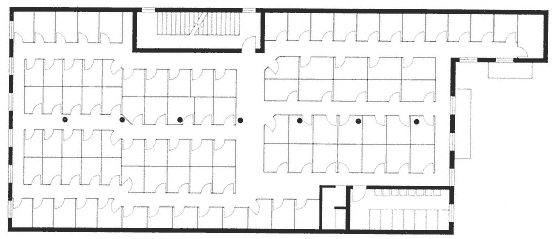
Figure 5.10
Typical floor plan with cubicles, ca. 1900. Reconstructed from a rough 1980s diagram of the
Kenton Hotel on the Bowery in New York City. Varied cubicle sizes and angled passageways
were common.
1905, 36 were of the full-room or cubicle type, 34 were of the open ward type, and the remaining 31 had both wards and cubicles. It was typical to put wards on the remote upper floors of tall buildings and cubicles on the second or third floor (fig. 5.10). Thousands of people in most large cities lived whole seasons and from year to year in cubicle and ward hotels.[33] Cubicle lodging houses had a direct building-type equivalent in crib or cage bordellos, some of them with hundreds of tiny cubicles, some fit with window shades that rolled up when patrons put in coins. Other bordellos and cheap lodging houses had canvas walls instead of matched lumber partitions.[34]
If a cubicle hotel offered heat (not all of them did), it came from over-worked and red-hot stoves often strategically blocking the narrow passages between cubicles. In some lodging houses, the only conditions worse than the heating supply were the vermin, general filth, and horrific smells, all resulting from the conditions of the tenants themselves, bad hotel maintenance, and poor ventilation. Lice, other bedbugs, and mice were constant problems. A San Francisco reporter wrote that "the persistent scratching of the sleepers proclaimed that their beds had other tenants that were not asleep."[35] During cold weather, people in the front or rear cubicles closed their windows, thus sealing the ventilation for the whole floor. In hot weather, the few windows (open or not) were completely inadequate. In short, year-round there was virtually no ventilation at all. In some corners, odors of urine or foul clothing overwhelmed tenants and visiting inspectors alike. Spittoons were everywhere, and one observer wrote that "it is the general custom in
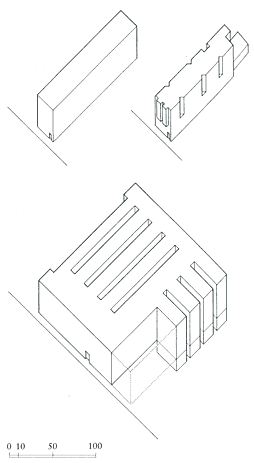
Figure 5.11
Three types of cheap lodging houses.
All were built in San Francisco from 1906 to
1909. Top left , a 39-room hotel annex in a loft
structure with no specialized light wells;
top right , a 35-room hotel on the two upper
floors with below-code light wells; bottom ,
the Central Hotel, with 440 tiny rooms and
minimal light wells satisfying early codes.
lodging houses to require those who spit profusely to spread a newspaper on the floor beside their beds."[36] In some cubicle hotels, as few as two toilets served 180 occupants. Bathtubs or showers may have been absent altogether. Residents might find one common drinking cup per floor and common towels that one critic compared to "those in a fourth-class printing office." Managers kept staff to a minimum; therefore, the beds, walls, and floors stayed unclean.[37]
Not surprisingly, disease conditions, social concerns, and fire dangers brought cheap lodging houses repeatedly to the attention of city officials. In 1917, the state of California outlawed construction of new cubicle hotels. Since that time, code enforcement and downtown development have gradually eliminated all cubicle rooms in San Francisco, although their use continued in the city through the 1950s. In Chicago, a 1963 sample of lodging house residents found that 75 percent of the 10,690 respondents still lived in cubicle hotels. Nine percent lived in
missions, and only 16 percent lived in private room hotels. In a 1986 estimate, New York City still had 3,500 people living permanently in cubicles and dormitory beds, some of the buildings dating from the 1890s.[38]
Most cubicle lodging houses were in temporary buildings or general-use lofts erected with light industrial or warehouse uses in mind (fig. 5.11). The Bonanza House was a 55-foot by 100-foot loft building that stood next to several similar buildings on San Francisco's Market Street in 1885. In the basement were a saloon and a bakery oven; an eating establishment occupied the first floor. The second and third floors were lodgings, probably of the cubicle sort, and a shoe factory occupied the top floor.[39] Not all cubicle hotels were such large structures. In 1906, the builders of Thomas Turish's lodging house in San Francisco's South of Market district fit sixteen rooms into what today would look like a long two-car garage—a one-story wood frame structure on a back alley lot with no apparent source of heat.[40]
Not even cubicle conditions matched the lowest lodging house variant, the flophouse. Ten-cent flophouses often occupied two or three floors of a loft building—one similar to those used for cubicle hotels but usually in poorer condition. Flops had no permanent installations whatsoever, rarely even beds. Some had mattresses or piles of rags with a blanket available. Others had long rows of canvas hammocks. Others simply offered customers a dry place on the floor where they could unroll their newspapers or bedrolls. Flophouse owners offered no lockers; there was little need of them since the tenants typically owned very little. Most flops did not open until winter, when migrant workers surged into the cities. They were temporary operations and moved from year to year, yet even flophouses with simple canvas slings could turn a profit. Riis knew one otherwise respectable and wealthy New Yorker who operated three such establishments and made $8,000 a year clear profit.[41]
Still lower on the commercial scale were informal private lodging houses—unlicensed dives where a lodger could sleep in a corner of a tenement room for 5 cents, or for 3 cents curl up in a sheltered hallway and not be moved out until morning. By the 1920s, the owners of all-night movie theaters had added to the urban landscape a variant of the flophouse. Local law in some cities (including San Francisco) closed movie theaters at night. Local law in other cities, such as Los Angeles,
allowed people to sleep all night for 5 cents in an uncomfortable wooden seat in a room that was at least dark and dry, if not well ventilated.[42]
While conditions in urban lodging houses could be bad, they were often better than those offered at distant road excavations, mines, or lumber camps. The nineteenth-century U.S. Army set the hoped-for standards for the peacetime industrial army; real conditions could be much worse. At one lumber camp in 1916, inspectors found tents with men crammed into triple makeshift bunks with only straw for mattresses. At Baltimore's suburban Sparrows Point steel plant in the 1890s, two thousand laborers (mostly recent immigrants and blacks) rented space in the plant's barracks—long rows of one-room shanties, 10 feet by 14 feet, built of rough pine boards and roofed with tar paper. Each room housed four men, who provided their own mattresses, stove, and fuel; only after 1904 were a shower house and cookhouse available. Low rent and direct proximity to work were the advantages; at $2 to $3 per month per man, only charity lodging houses could have beaten the price.[43]